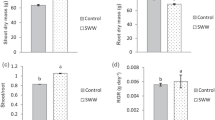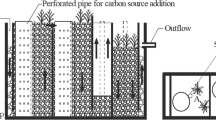Abstract
The aquatic pteridophyte Azolla, a small-leaf floating plant, which lives in symbiosis with a nitrogen fixing cyanobacteria, Anabaena azollae, was widespread throughout water channels and hydrographic basins of Portugal. Azolla is also the aim of a study for its utilization as a biofilter for wastewater purification, namely for phosphorus removal (± 36%). The goal of this work is to compare the growth characteristics and biomass composition of this water fern in natural ecosystems with those obtained in some wastewaters. Plant growth rate (0.107± 0.037 d-1) and productivity (5.8 g dw m-2 d-1) suggest that Azolla can grow well in partially treated domestic wastewater, but not in diluted pig wastes. This fact, associated to its biomass composition, namely in phosphorus content (1.38 ±0.20%), increase the possibility of this plant being used to improve wastewater discharge quality. It may also be possible to use the biomass as a biofertiliser or as a feed supplement for aquatic and terrestrial animals due to its protein, crude fiber and mineral content.
Similar content being viewed by others
References
APHA, AWWA, APCF, 1992. Standard methods for the examination of water and wastewater. 20th American Public Health Association, Washington.
AOAC, 1990. Official methods of analysis, 15th edn., Vol II.
Barber, S. A., 1995. Soil nutrient bioavailability, 2nd edn., John Wiley & Sons, Inc., New York: 157–179.
Bishop, P. L. & T. T. Eighmy, 1989. Aquatic wastewater treatment using Elodea nuttallii. Journal WPCF 61: 641–648.
C.E.I.P., 1980. Tables de composition des matiers premiers destinées à alimentation animale. 1 - valeurs chimiques.
DeBusk, T. A. & J. H. Ryther, 1987. Biomass production and yields of aquatic plants. In Reddy, K. R. & W. H. Smith (eds), Aquatic Plants for Water Treatment and Research Recovery. Florida: 579–598.
DeBusk, T. A., K. R. Reddy, T. D. Hayes & B. R. Schwegler, 1989. Performance of a pilot-scale water hyacinth-based secondary treatment system. Journal WPCF 61: 1217–1224.
Costa, M. L., F. Carrapiço & M. C. R. Santos, 1994. Biomass and growth characterization of Azolla filiculoides in natural and artificial environments. In Hegazi, N. A., M. Fayez & M. Monib (eds), Nitrogen Fixation with Non-Legumes. The American University in Cairo Press: 455–461.
Costa, M. L., F. Carrapiço & M. C. R. Santos, 1996. Contribuição para o estudo da utilização de Azolla no tratamento de águas residuais domésticas. In Borrego, C., C. Coelho, L. Arroja, C. Bóia & E. Figueiredo (eds), Proceedings 5a Conferência Nacional Sobre a Qualidade do Ambiente 2. Aveiro, Portugal: 1945–1954.
Fisher, J. P., 1988. Wastewater treatment using aquatic plants. In (eds),Alternative Waste Treatment Systems, Rao Bhamidimarri, Elsevier Applied Science, Palmerston North, New Zealand: 34–44.
Kitoh, S., N. Shiomi & E. Uheda, 1993. The growth and nitrogen fixation of Azolla filliculoides Lam. in polluted water. Aquat. Bot. 46:129–139.
Kumar, P. & R. J. Garde, 1989. Potentials of water hyacinth for sewage treatment. Journal WPCF 61: 1702–1706.
Kumarasinghe, K. S. & D. L. Eskew, 1993. Isotopic studies of Azolla and nitrogen fertilization of rice, Kluwer Academic Publishers, London: 42–54.
Lumpkin, T. A. & D. L. Plucknett, 1980. Azolla: botany, physiology and use as green manure. Econom. Bot. 34: 111–153.
M.A.D.R.P., 1997. Código de boas práticas agrícolas para a protecção da água contra a poluição com nitratos de origem agrícola, Ministério da Agricultura, do Desenvolvimento Rural e das Pescas, Lisboa.
Martins, M. I. F. M., 1996. Maize nitrogen fertilisation in fluvisoles of the lower Mondego valley - Field trials, In Van Cleemput, O. G. Hofman & A. Vermossen (eds), Progress in Nitrogen Cycling Studies, Kluwer Academic Publishers, London: 223–229.
Mian, M. H. & A. K. M. Azmal, 1989. The response of Azolla pinnata R. Brown to the split application of phosphorus and the transfer of assimilated phosphorus to flooded rice plants, Plant Soil 119: 211–216.
Moorhead, K. K. & K. R. Reddy, 1987. Nitrogen cycling in an integrated 'biomass for energy' system. In Reddy, K. R. & W. H. Smith (eds), Aquatic Plants for Water Treatment and Research Recovery, Florida: 535–542.
Oron, G., 1990. Economic considerations in wastewater treatment with duckweed for effluent and nitrogen renovation. Journal WPCF 62: 692–696.
Reddy, K. R. & W. F. DeBusk, 1985. Growth characteristics of aquatic macrophytes cultured in nutrient-enriched water: II. Azolla, duckweed and Salvinia, Econom. Bot. 39: 200–208.
S.A.P.E.C., 1989. Manual de adubação, 2nd. edn., SAPEC - Adubos Agro, S.A.
Vicenzini, M., M. C. Margueri & C. Sili, 1985. Outdoor mass culture of Azolla spp.: yields and efficiency of nitrogen fixation. Plant Soil 86: 57–67.
Watanabe, I. & C. M. Ramirez, 1984. Relationship between soil phosphorus availability and Azolla growth. Soil Sci. Plant Nutr. 30: 595–598.
Author information
Authors and Affiliations
Rights and permissions
About this article
Cite this article
Costa, M.L., Santos, M.C. & Carrapiço, F. Biomass characterization of Azolla filiculoides grown in natural ecosystems and wastewater . Hydrobiologia 415, 323–327 (1999). https://doi.org/10.1023/A:1003824426183
Issue Date:
DOI: https://doi.org/10.1023/A:1003824426183




